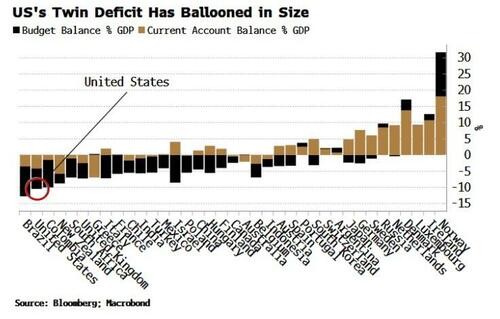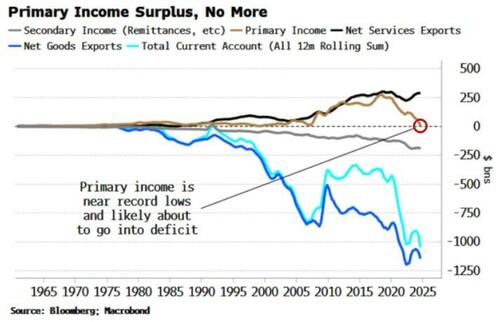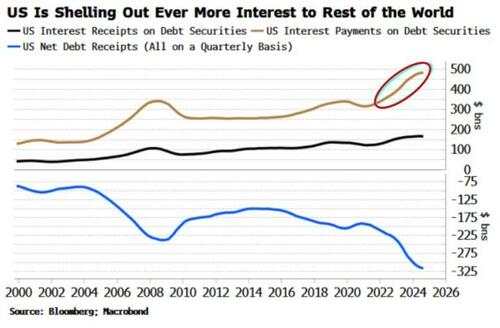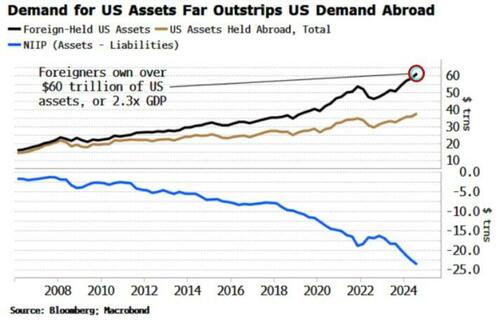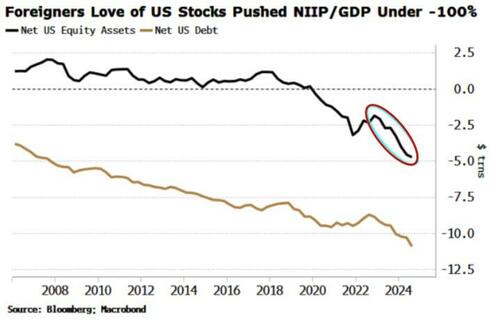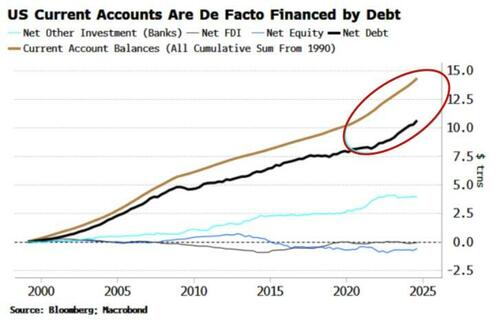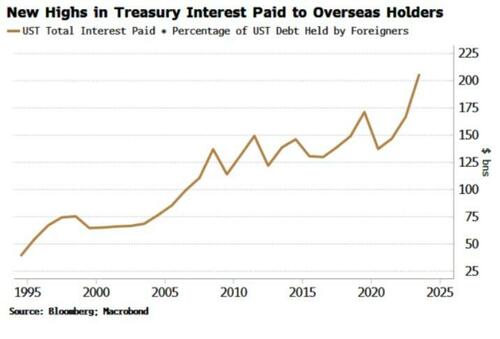Dollar Downside - Is Exorbitant Privilege Becoming A Curse?
Authored by Simon White, Bloomberg macro strategist,
The US is increasingly indebted to the rest of the world, fomenting financial risks and leaving the dollar prone to a selloff.
America’s currency has started this year on a strong footing, continuing from 2024 when Donald Trump’s election victory catapulted the DXY index 8% higher in a little over three months. But US exceptionalism and its “exorbitant privilege” – the advantage of having the world’s reserve currency – is leaving the structural underpinning of a strong dollar on more unstable ground.
The putative low-tax, regulation-lite, business-friendly incoming US administration is supercharging growth expectations, supporting yields and pushing the dollar higher. But investors’ seemingly insatiable demand for US assets is leaving the country ever more in hock to the rest of the world. The dollar’s reserve status should prevent this from turning into a crisis, but it does leave the dollar more prone to repricing lower to reflect the US deficits.
And they are large and growing. The US twin deficit (current-account plus fiscal) is now the biggest of the major EM and DM countries in GDP terms, bar Brazil.
It is already well known the US is running a large fiscal deficit. What is likely to draw more attention this year is its sizable and growing current-account deficit.
Most people’s eyes glaze over when external accounts are discussed, but they are crucial to understanding the financial risks that face a country. The size of the US deficit, the rate at which it’s growing, and some of its underlying features highlight that the dollar is liable to face downward pressure in order to accurately reflect burgeoning structural vulnerabilities.
To repeat, the US is not about to face anything like a balance-of-payments crisis. But a weaker dollar is likely to be part of the adjustment mechanism, so that increasingly unattainable earnings expectations for US assets can be met.
The biggest portion of the US current account is the goods deficit. But it is the primary-income balance we need to watch closely. It has always been in surplus on an annual basis, as the US receives more in receipts from its portfolio assets and foreign direct-investment (FDI – factories and other physical assets) held abroad than it pays on US assets held by foreigners. However, this is poised to go into deficit for the first time.
This change is partly down to a fall in FDI receipts, but much more important is the rise in what the US is paying on its portfolio assets held by foreigners. Digging further, we find that the US has seen an almost 70% rise - to just under $500 billion per year - in its payments to foreign debt holders.
This is the consequence of borrowing so much from the rest of the world, leaving the US more exposed to rising global interest rates.
These debts add up. The net international investment position (NIIP) is, ex-valuation effects, the cumulative sum of current-account balances. As a consequence of running persistent deficits, the US has just passed an unwelcome milestone: as of the end of the third quarter last year, its NIIP exceeded -100% of GDP for the first time, from only -10% in 2006.
The US owns assets held abroad to the tune of $38 trillion. But that is dwarfed by the $62 trillion – and rising quickly – of US assets owned by foreigners, leading to the deeply negative NIIP.
The culprit? US exceptionalism. Overseas investors’ “there-is-no-alternative” attitude to US assets has caused the country’s liabilities to swell over the last two years. But that’s not because there’s been a flood of foreign companies building factories in the US, or that banks’ external liabilities have increased. Instead, foreigners have been purchasing far more US assets – debt, but especially equities - than Americans have been buying abroad.
Net FDI also contributed about a third of the NIIP decline since 2022, but this is largely to do with FDI valuations being implied from the performance of US stock markets. While net FDI remains steady at current prices, equity outperformance has pushed its value at market prices much lower.
Still, by far the biggest component of the overall NIIP is debt, accounting for almost half the total. In fact, as Brad Setser points out in his Council on Foreign Relations blog, the US has effectively funded its current-account deficits through foreigners buying its debt (as mentioned above, the NIIP is approximately the sum of current accounts ex-valuation effects).
Portfolio flows have the potential to be more flighty than other flows. Exorbitant privilege or not, the US is exposed to financing risk, where a rapid rise in global interest rates would potentially force it to partially close its external deficits with the rest of the world.
Even before that possibility, though, the cessation of the US primary-income surplus shows foreigners are extracting more financial wealth from the country than it is obtaining from the rest of the world. And the US is taking on more and more debt to fund this and the goods deficit. The interest paid to foreign holders of Treasury debt alone is at all-time highs.
This year, Trump has the potential to significantly influence external cash flows, principally through tariffs or potentially through changes to the corporate tax regime, e.g. changing the tax charged on offshore profits (as most FDI receipts come from US subsidiaries based in tax havens).
These could move the dollar either way. But having already priced in the anticipated positive effects of Trump policy, the currency looks more vulnerable to the downside given sky-high equity valuations, and the potential for foreign investors reassessing America’s unquenchable appetite for debt.


